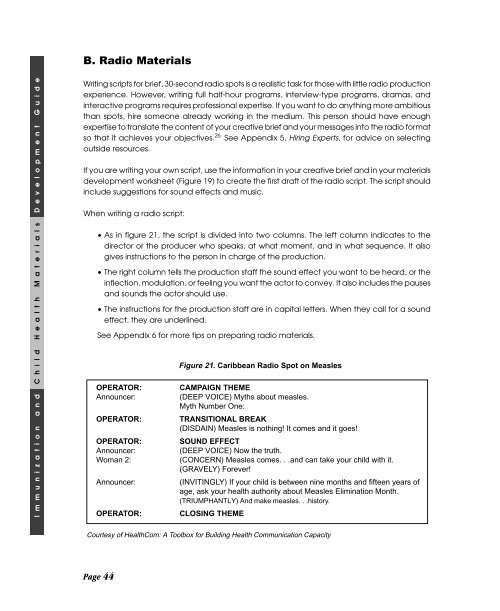Immunization and child health materials development guide pdf
Immunization and child health materials development guide pdf
Immunization and child health materials development guide pdf
Create successful ePaper yourself
Turn your PDF publications into a flip-book with our unique Google optimized e-Paper software.
B. Radio Materials<br />
Writing scripts for brief, 30-second radio spots is a realistic task for those with little radio production<br />
experience. However, writing full half-hour programs, interview-type programs, dramas, <strong>and</strong><br />
interactive programs requires professional expertise. If you want to do anything more ambitious<br />
than spots, hire someone already working in the medium. This person should have enough<br />
expertise to translate the content of your creative brief <strong>and</strong> your messages into the radio format<br />
so that it achieves your objectives. 26 See Appendix 5, Hiring Experts, for advice on selecting<br />
outside resources.<br />
If you are writing your own script, use the information in your creative brief <strong>and</strong> in your <strong>materials</strong><br />
<strong>development</strong> worksheet (Figure 19) to create the first draft of the radio script. The script should<br />
include suggestions for sound effects <strong>and</strong> music.<br />
When writing a radio script:<br />
• As in figure 21, the script is divided into two columns. The left column indicates to the<br />
director or the producer who speaks, at what moment, <strong>and</strong> in what sequence. It also<br />
gives instructions to the person in charge of the production.<br />
• The right column tells the production staff the sound effect you want to be heard, or the<br />
inflection, modulation, or feeling you want the actor to convey. It also includes the pauses<br />
<strong>and</strong> sounds the actor should use.<br />
• The instructions for the production staff are in capital letters. When they call for a sound<br />
effect, they are underlined.<br />
See Appendix 6 for more tips on preparing radio <strong>materials</strong>.<br />
Figure 21. Caribbean Radio Spot on Measles<br />
OPERATOR:<br />
Announcer:<br />
OPERATOR:<br />
OPERATOR:<br />
Announcer:<br />
Woman 2:<br />
Announcer:<br />
OPERATOR:<br />
CAMPAIGN THEME<br />
(DEEP VOICE) Myths about measles.<br />
Myth Number One:<br />
TRANSITIONAL BREAK<br />
(DISDAIN) Measles is nothing! It comes <strong>and</strong> it goes!<br />
SOUND EFFECT<br />
(DEEP VOICE) Now the truth.<br />
(CONCERN) Measles comes. . .<strong>and</strong> can take your <strong>child</strong> with it.<br />
(GRAVELY) Forever!<br />
(INVITINGLY) If your <strong>child</strong> is between nine months <strong>and</strong> fifteen years of<br />
age, ask your <strong>health</strong> authority about Measles Elimination Month.<br />
(TRIUMPHANTLY) And make measles. . .history.<br />
CLOSING THEME<br />
Courtesy of HealthCom: A Toolbox for Building Health Communication Capacity<br />
Page 44

















